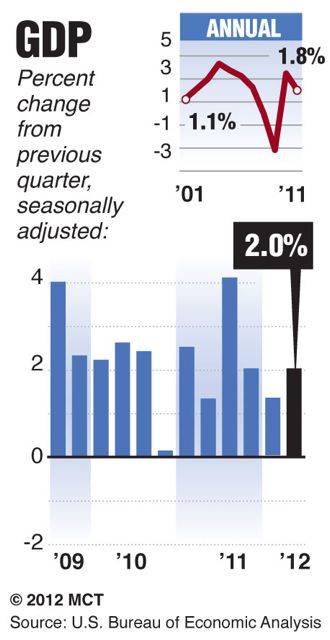
By Jim Puzzanghera, Los Angeles Times –
WASHINGTON — Fueled by government and consumer spending, the U.S. economy expanded at a 2 percent annual rate in the three months ended in September. That was stronger than analysts had expected, but still well short of the horsepower needed to drive a robust recovery.
The moderate growth rate reported Friday by the Commerce Department was a significant improvement over the weak 1.3 percent pace in the second quarter. And it stilled concerns that U.S. economic output might be stalling.
“U.S. economic growth is slow, but not slowing,” said Kathy Bostjancic, director for macroeconomic analysis at the Conference Board.
A burgeoning residential housing market helped stoke growth as did a surprising increase in federal defense spending.
But there were some potentially ominous signals in the report, notably the first drop in business capital expenditures since early 2011. Many company owners are concerned about the so-called “fiscal cliff” — looming tax increases and government spending cuts that will take effect in January unless Congress acts to prevent them.
The latest reading on gross domestic product provided one of the last major data points before Election Day in a presidential race focused on the economy.
President Barack Obama and Republican challenger Mitt Romney each cited the report Friday to back up their last-minute pitches to voters.
The Obama campaign said the increased growth — the 13th-straight month of expansion since the recession technically ended — “is more evidence that our economy continues to come back from the worst recession since the Great Depression under President Obama’s leadership.”
But Romney called the report “the latest round of discouraging economic news.”
“Slow economic growth means slow job growth and declining take-home pay,” Romney said at a chilly outdoor rally in Ames, Iowa. “That’s what four years of President Obama’s policies have produced.”
But both sides were reading too much into the report, which will be revised twice before the end of the year, said Bernard Baumohl, chief global economist for the Economic Outlook Group.
“It’s going to be sort of the GDP mouse that roared,” he said. “In the final analysis, what we’ve got is a recovery that continues, but at an agonizingly slow pace.”
Economic growth has been erratic since the deep, 18-month recession ended in June 2009. After the growth rate reached a post-recession high of 4.1 percent in the final three months of last year, activity fell off in 2012 as the European debt crisis intensified.
A recession in Europe and a deceleration in China reduced demand around the world and helped pull U.S. economic growth down in the first half of the year.
The global slowdown continued to be a drag in the U.S. in the third quarter, with exports decreasing 1.6 percent from the previous quarter. It was the first such contraction since the recession ended.
“The slump in Europe has gotten deeper, and we have seen consecutive quarters where economic growth in China is slowing, so it doesn’t surprise us at all that exports have dropped off and that is obviously hurting U.S. economic activity and manufacturing,” Baumohl said.
The drought in the Midwest also affected U.S. growth, though not as much as in the second quarter. And business capital expenditures dropped 1.3 percent from the second quarter, as companies probably began holding back spending out of fear of the impending fiscal cliff.
“The business community is not investing, but the government is spending,” said Peter Schiff, chief executive of investment firm Euro Pacific Capital Inc. “When you break it down, the lion’s share of the growth is coming from government spending.”
Government spending increased 9.6 percent in the third quarter from the previous three-month period, the first such increase since 2010. The driver was federal defense spending, which was up 13 percent, the biggest jump since the second quarter of 2009.
The economy also was boosted in the third quarter by spending on real residential fixed investment, an indication of housing market strength, which grew at a 14.4 percent annual rate in the third quarter. And real personal consumption expenditures, a reading on consumer activity, increased 2 percent in the third quarter.
“Overall, the economy still has only weak forward momentum,” said Nigel Gault, chief U.S. economist at IHS Global Insight. “Some underlying fundamentals are improving — most importantly, housing. But uncertainty at home and abroad is holding back the business sector. How quickly those uncertainties clear up — especially over domestic fiscal policy — will determine how quickly the overall growth rate can pick up.”






